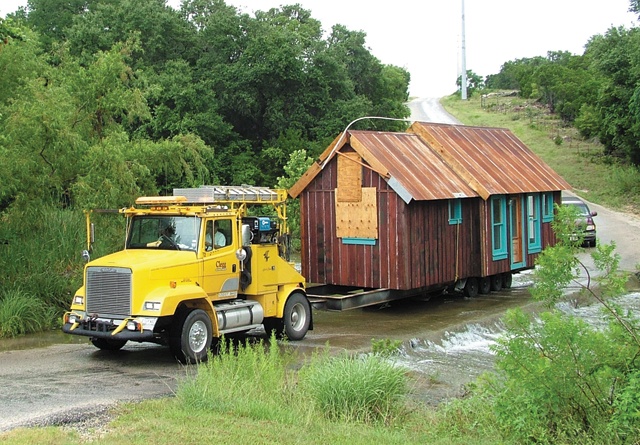Thunder crackles directly over the Dairy Queen in Kyle. The tiny antique house sits uncovered on a trailer in the parking lot, its longleaf pine exterior drenched a darker red from the morning’s journey in the rain.
This is a jittery day for Brad Kittel, owner and creator of a Luling-based business called Tiny Texas Houses, who’s wolfing down his lunch inside the restaurant. Time to get back on the road. He’s delivering his first tiny house today—a 490-square-foot, $47,500 gem with turquoise-painted windows to his first contract customer, an artist near Austin—and, oh baby, is this July weather unpredictable.
One minute it’s raining, the next it’s not. A finger of lightning jabs from the sky. But stormy weather can’t rattle this old house: Even though just built, its reclaimed Texas longleaf and loblolly pine wood, and an antique ensemble featuring a cast-iron porcelain bathtub and an 1880s front door with the original glass, give this house, all components together, an average age of 100.
So Kittel, a work crew and John Clegg, who drove his house-moving rig up from Victoria to Luling, scurry out of the Dairy Queen and back into their vehicles as the clouds open up again. It’s time to make one very special house call.
The tiny house’s 11 brightly colored windows and the flashing yellow lights on Clegg’s yellow truck provide a cheerful palette against a bruised sky as the entourage zips along back roads to County Road 367 southwest of Austin. There, artist Tara Weaver, a member of Pedernales Electric Cooperative, awaits her new house, set for conversion into a tiny art studio overlooking full-running Bear Creek.
“Let’s see how it likes it,” Weaver says after the house rolls down the steep county road, through a low-water crossing, under a canopy of trees (one live oak requires trimming to allow narrow passage for the house’s corrugated steel roof) and snuggles into its new quarters. All with nary a scratch.
If Tiny Texas Houses has a theme, it’s that portability doesn’t require a wide-load moving sign. But even more significant, the tiny houses serve as portals, a concatenation of past and present in which Kittel rescues and recycles materials from time’s refuse heap—stained glass, wavy glass, bathtubs, sinks, windows, cabinet latches, door hinges, doorknobs, cypress wood, old Texas pine harvested virtually to the point of extinction—and fashions the pieces into new, yet antique houses built to last another 100 years.
“I’m a firm believer in saving what we’ve got,” said Kittel, who, with his wife, Suzanne, owns and operates Discovery Architectural Antiques in Gonzales. The 140,000-square-foot operation provides the materials for Tiny Texas Houses, which opened in October 2006 in neighboring Luling.
“That was part of the whole reason behind doing Tiny Texas Houses,” Brad Kittel said. “To prove that you can build something from nothing. Everything that we’re building out of is somebody’s nothing. It was of no value or very little value to them.”
A few weeks after its delivery, Weaver had filled her tiny house with paintbrushes, canvasses and her completed works. The studio is now art itself, seemingly hanging like a painting from an invisible wire between hackberry trees. Even the turquoise windows blend naturally into the surrounding greenery.
“I’ve really started asking for what I want these days, and it’s working,” the 50-year-old Weaver said, reaching out her arms, palms open toward her easel and the windows and the light streaming in. “Look at this.”
As business grows, Kittel’s customers learn they can ask him for what they want. Consider Libby and Charles Heath, San Bernard Electric Cooperative members, who needed space for their cats when they moved from East Bernard to Columbus.
Libby Heath saw an ad for Tiny Texas Houses. Problem solved. “The cats and I will be fighting over this place,” she said of the $26,000, 160-square-foot house that’s mostly longleaf pine and sports a kitchen for cat food preparation, lounging islands, a porch and a kitty door.
Kay Love of Austwell, a member of Guadalupe Valley Electric Cooperative who raises registered Brahman cattle near Stockdale, is moving a custom-built tiny house onto her farm so she can split time between her two places.
“It will put a roof over my head, and it will look cute in the pasture,” she said.
Kittel’s tiny houses feature old-growth pine, which he revives from various sources, including churches and lumberyards. The longleaf pine for Weaver’s studio came from a Shiner lumberyard, where about a century ago, the wood made up the walls and roof around lumber storage bins. In the 1800s, the same wood stood as a barn.
Old-growth longleaf pine trees were all but harvested by the early 1900s, and now only remnants remain of the longleaf forest that once composed 5,000 square miles of East Texas’ Piney Woods.
Longleaf pines grow straight and tall with densely packed rings that make strong wood, explained David Riskind of the Texas Parks and Wildlife Department’s natural resources department.
“They don’t make it like that any more,” he said.
Brad Kittel, 51, hopes that someday, people will say the same thing about his tiny houses. They can be passed from generation to generation and make ideal guest homes, he said.
As a couple, the Kittels have long been bringing homes back to life. From 1985 to 1997, they rehabilitated and sold East Austin houses through their real estate business, and in 1994, Brad Kittel received the Ernst & Young Socially Responsible Entrepreneur of the Year award.
Now, the Kittels oversee a sprawling (but meticulously clean) antiques business that’s so big sometimes only a verbal inventory will do. “Pieces and parts, pieces and parts,” Brad happily muttered one day in Luling as he strolled past an antique breakfast nook.
And this from Suzanne, in Gonzales, in an old warehouse stuffed with … “Doors, doors, doors!” she merrily proclaimed, marching past hundreds of them, stacked vertically like dominoes.
As customers come knocking, Tiny Texas Houses maintains a fussy focus. While showing off an 1890s multipaned stained glass in a Victorian-style model house, Brad Kittel pulled an all-purpose tool out of his pocket. Still talking, he tightened the front door’s post-1900 wrought doorknob.
That same day, project manager Patrick Moreno asked Kittel about a latch on an improperly tightening window. Kittel tested the latch. Position it differently, he said. I then asked to hold the latch, reading the inscribed date: Feb. 7, 1871.
Moreno reveres the tiny houses. “Pretty neat looking, aren’t they?” he asked, admiring an antique bead board ceiling. “It looks like you’re stepping back in time.”
The same can be said of the setting along Bear Creek, where Tara and her husband, Tab Weaver, live in an 1860s farmhouse that overlooks her studio.
“It looks like it’s been there forever,” Kittel said. “That’s the goal.”
——————–
Tiny Texas Houses is just south of Luling at 20501 E. IH-10. For more information, call (512) 636-6756, (830) 875-2500 or (830) 672-2428 or go to www.tinytexashouses.com. For more information on Discovery Architectural Antiques in Gonzales, call (830) 672-2428 or go to www.discoverys.com.
Camille Wheeler wrote “Highway Havens” in the July 2007 Texas Co-op Power.


